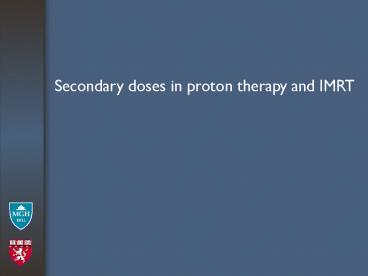Blueberry - PowerPoint PPT Presentation
1 / 12
Title: Blueberry
1
Secondary doses in proton therapy and IMRT
2
Secondary doses in proton therapy and IMRT
Zacharatou Jarlskog C and Paganetti H The risk
of developing second cancer due to neutron dose
in proton therapy as a function of field
characteristics, organ, and patient age.
International Journal of Radiation Oncology,
Biology, Physics in press
3
Where are the neutrons coming from in passive
scattered proton therapy ?
4
Neutron yield depends on aperture size
Neutron dose generated in the treatment head
(typically) decreases with increasing treatment
volume
20 of the beam treats 80 of the beam produces
neutr.
60 of the beam treats 40 of the beam produces
neutr.
5
Relative contribution of external neutrons to
thyroid cancer risk as a function of field index
Zacharatou Jarlskog C and Paganetti H The risk
of developing second cancer due to neutron dose
in proton therapy as a function of field
characteristics, organ, and patient age.
International Journal of Radiation Oncology,
Biology, Physics in press
6
How do neutron equivalent doses in proton therapy
compare to doses from CT imaging ?
7
Putting it into perspective protons vs. imaging
Zacharatou Jarlskog et al. (2008). Assessment of
organ-specific neutron equivalent doses in proton
therapy using computational whole-body
age-dependent voxel phantoms. Phys Med Biol, 53,
693-717
8
What is the risk for developing second
malignancies ?
9
Organ equivalent dose after HN tx
thyroid (circles) lung (squares)
liver (triangles)
Zacharatou Jarlskog et al. (2008). Assessment of
organ-specific neutron equivalent doses in proton
therapy using computational whole-body
age-dependent voxel phantoms. Phys Med Biol, 53,
693-717
10
Field 1 Field 2 Field 3
Zacharatou Jarlskog C and Paganetti H The risk
of developing second cancer due to neutron dose
in proton therapy as a function of field
characteristics, organ, and patient age.
International Journal of Radiation Oncology,
Biology, Physics in press
11
The risk associated with neutron doses in proton
therapy is presumably smaller than the lifetime
baseline risk for most fields
The risk associated with neutron doses in proton
therapy is similar to the risk associated with
scattered photon doses in IMRT or CT
The uncertainties when estimating neutron
equivalent doses in proton therapy are bigger
than for scattered IMRT and CT doses
The integral dose in proton therapy is roughly a
factor of 2-3 lower than with any type of photon
therapy
12
Research to be done
What is the difference between IMRT, passive
scattered proton therapy, and scanned beam proton
therapy in terms of out-of-field organ specific
absorbed dose and equivalent dose as a function
of treatment field ? How does this depend on
patients age?
Such studies can help to reduce our uncertainties
in risk models in the long run !































